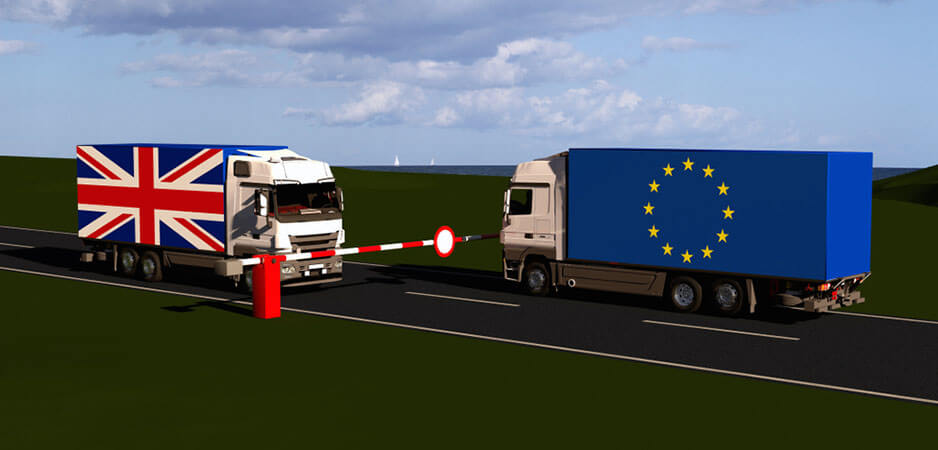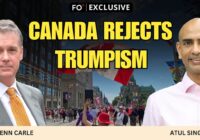The Irish backstop is simply an effort to mitigate the damage that Brexit causes to peace in Ireland and the UK. Former Irish Prime Minister John Bruton explains.
It puzzles many people in Britain that something known as an “Irish backstop” should be at the heart of an increasingly bitter dispute. This is over the deal the UK government has made with the European Union on the terms for Brexit.
Most people understand that when the UK leaves the EU on March 29, the only land boundary between the United Kingdom and the European Union will be the 300-mile-long border in Ireland. Some do understand that if the UK leaves the EU, there will have to be border controls. After all, leaving the union was supposed to be about taking back “control,” and given that countries can only exercise control in their own territory, there is a logical necessity to have controls at the border of a country’s territory.
This is not something made up by the EU to annoy Brits, but is a logical consequence of Brexit, which is, as we all know, something Britons have chosen for themselves and not something imposed on them by the European Union.
The proposed backstop in British Prime Minister Theresa May’s deal with the EU involves the whole of the UK staying in a close customs arrangement with the union. The original idea was that the backstop would be confined to Northern Ireland, but the British government preferred a backstop arrangement that would cover the whole UK, so as to minimize the controls that would otherwise have to be imposed between Britain and Northern Ireland. The object of the entire exercise is to avoid having controls at the 300 crossing points between Northern Ireland and the Republic of Ireland.
Some in Britain think the UK should be free to leave the EU, and that the British and Irish governments should then just decide, between themselves, that they were simply not going to have controls on the Irish border. That would not work because Ireland would still be in the European Union and would be breaking EU rules if it failed to control its portion of the EU land border.
Apart from being illegal, it would be impractical. The UK, once outside the European Union, would immediately go off and try to make trade deals with non-EU countries. These would inevitably involve agreeing to different standards and tariffs on goods coming from these non-EU countries to the ones that the European Union (including Ireland) would be applying to these nations. So, if there were no controls on the Irish border, goods from these non-EU states with which the UK had made its own trade deals could enter the European Union via Northern Ireland, without complying with EU standards or paying EU tariffs.
That would destroy the single market, which is based on common rules and tariffs, made, enforced and interpreted in the same way for all 27 EU members, including the Republic of Ireland.
Outside of the EU, under World Trade Organization (WTO) rules, the United Kingdom would also have to impose tariffs on its side of the Irish border — unless it wanted to collect no tariffs at all — on goods coming into the UK from any country in the world. This is because of a WTO rule that says in the absence of a broad trade agreement, a country cannot discriminate between WTO member countries in the rate of tariffs it charges on goods coming from those countries (the most favored nation rule).
So, in the absence of a trade deal with the EU, the UK must charge the same tariffs on Irish goods as it would charge on goods coming from any WTO members, with whom it has no trade deal — which, if the UK leaves the EU without a deal, would be every WTO country. If it attempted to discriminate unilaterally, the UK would be taken to the WTO court by some or all of the WTO countries who would not be getting the same concessions.
The UK is a trading nation. As such, it benefits from a rules-based world trading system. So, it would not be in the UK’s interest to start breaking WTO rules on the day it left the EU, just to solve a problem that is of its own making.
THE TWO ALLEGIANCES IN IRELAND
The other big reason for having an Irish backstop and for avoiding a hard border is about human beings, rather than just about commerce. For the past four centuries, two communities with different allegiances have lived together, geographically intermingled, in the Irish province of Ulster.
One community feels a sense of allegiance to Britain, its monarch, its historic narrative and its flag. The other feels an allegiance to Ireland and identifies itself with different historic narrative and different symbols. The two communities have different religious allegiances too, but the disagreements between them are not primarily about religious matters — they are all about national identity.
For centuries, the contest between these two identities was a zero-sum game. Either the British identity had to win or the Irish identity had to win. That zero-sum approach led to wars, threats of wars or uprisings from the 17th century all the way up until the late 20th century. These conflicts caused many casualties in Ireland and in Britain, too.
British and Irish political leaders have, for the last 40 years, been trying to find a different way forward. Rather than a zero-sum game where if one identity won, the other had to lose, these leaders sought to create conditions in which both identities could coexist comfortably together within Northern Ireland, without either of them winning or losing. The aim was to ensure that neither would feel cut off from the focus of their emotional allegiance. The nationalists would not feel cut off from Dublin, and Unionists would not feel cut off from London or the “mainland” as they would call it.
The Belfast Agreement of 1998 achieved this. Crafted between Ireland and the United Kingdom, when both were members of the barrier-free EU, it created structures to have a comfort zone for both communities. This was done through establishing three interlocking structures of cooperation, incorporated in an overarching international treaty, namely: power sharing within Northern Ireland; cooperation between north and south; and cooperation between Dublin and London. On the strength of this agreement, Ireland changed its constitution to remove a territorial claim it had on Northern Ireland.
Now, 20 years later, the UK’s decision to leave the European Union puts these structures at risk because Brexit requires barriers to go up between the UK and Ireland, where previously there was free exchange. This is why, at a meeting in London, long before the referendum in 2016, I described Brexit as an “unfriendly act” by the UK vis-à-vis my country.
The backstop is simply an effort to mitigate the damage. It is a second-best option — and a bad second best at that. The only option that will not damage the structure of peace we have so painstakingly built between Ireland and Britain, and within the island of Ireland, would be for the UK to decide to stay in the EU after all.
The views expressed in this article are the author’s own and do not necessarily reflect Fair Observer’s editorial policy.
Support Fair Observer
We rely on your support for our independence, diversity and quality.
For more than 10 years, Fair Observer has been free, fair and independent. No billionaire owns us, no advertisers control us. We are a reader-supported nonprofit. Unlike many other publications, we keep our content free for readers regardless of where they live or whether they can afford to pay. We have no paywalls and no ads.
In the post-truth era of fake news, echo chambers and filter bubbles, we publish a plurality of perspectives from around the world. Anyone can publish with us, but everyone goes through a rigorous editorial process. So, you get fact-checked, well-reasoned content instead of noise.
We publish 3,000+ voices from 90+ countries. We also conduct education and training programs
on subjects ranging from digital media and journalism to writing and critical thinking. This
doesn’t come cheap. Servers, editors, trainers and web developers cost
money.
Please consider supporting us on a regular basis as a recurring donor or a
sustaining member.
Will you support FO’s journalism?
We rely on your support for our independence, diversity and quality.







